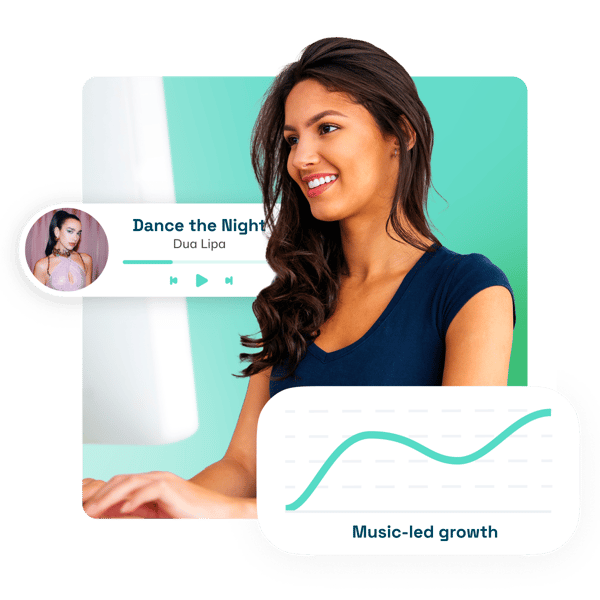Why music-led growth is a secret weapon for app engagement

Back in 2015, when we started helping brands get popular music into their apps, the problems were clear; there was a big gap in the market and no plug-and-play solution for businesses to license and integrate commercial music for digital use.
We have always believed in the power of music to positively impact people's lives and help businesses grow. The problem with the latter was that there were not many solutions that could show the direct impact that music had on important digital business metrics like user engagement rates and retention rates. So, we built a music API that enabled us to see the impact that music had on all of our customers’ user metrics.
Then the data started rolling in; from longer session times to increased user retention, our customers were seeing big improvements in key metrics—music was propelling their businesses forward.
...from longer session times to increased user retention, our customers were seeing big improvements in key metrics—music was propelling their businesses forward.
With product-led growth, we let our tech do the talking, building best-in-class features that keep users coming back for more, but what if your tech didn’t just talk? What if it could sing?
This is the power of music and the story of music-led growth.
Today’s race for attention
Fast forward to today. App publishers and developers are struggling with engagement. There are almost 3.8 million apps in the Google App Store and 2 million iOS apps in the Apple App Store. 36 thousand more apps are released every month. Should an app manage to claw its way through the noise and onto someone's home screen, chances are that it will be deleted within 30 days. On average, only 7.5% of new app users are still using it 10 days after they downloaded it.
How do you fight for attention in this environment?
Cost of admission
The price of entry for an attention-worthy digital product is an experience that is fast and easy to use, constantly updated with fresh content and information, easily connected with other apps and products, and effectively and relentlessly personalized.
Music is one of the few dependable mediums that can help a product forge a more emotional, personal connection with its users. And yet, many product teams still overlook this powerful resource.
Apps need a new way to think about music as a driver for their business - we’re calling it music-led growth.
Music-led growth - a sonic strategy to fuel engagement
If you want to continually strengthen engagement with customers, music is one of the best forms of content to leverage.
Music is a key ingredient in our most engaging experiences because our brain is wired to respond to it. It has the power to change our mood.
It’s why brands like Fortnite, TikTok, Meta, and Twitch have invested millions in licensing and curating music from popular (and trending) artists into their digital experiences.

Music-led growth (MLG) is an engagement strategy that utilizes data-driven music integration to drive business results. The MLG approach helps product teams create more immersive experiences, reduce churn, and turn users into advocates—fueling word-of-mouth growth.
Music works
Retention rates are arguably the most important KPI for apps - often tied with user growth rates for quantifying success. With over 10 years of app engagement data across many different verticals, we’ve consistently found that professionally curated music integrated directly into apps makes a real difference in both engagement and retention.
.png?width=415&height=415&name=retention%20session%20times(1).png)
In 2022, we measured session lengths for millions of unique users and found that when they listened to Feed.fm-integrated popular music, their session times were 3.2X as long as users who had no music.
But, the real winner is in D90 retention. When users listened to Feed.fm music, they were 1.7X as likely to stick around over 90 days. That is a material impact on an app’s bottom line.
Music’s ability to impact a digital experience positively is no secret. Over the past half-century, countless studies have shown the positive correlation between music and activities as diverse as exercise and shopping.
Why music works
Music activates nearly our whole brain with powerful effects across motivation, memory, focus, and relaxation. Music impacts BOTH behavior and physiology. It can be a motivator and mood lifter, triggering dopamine production. It can even have a long-term physiological effect, rewiring our brains in a process called neuroplasticity.
Why don’t more apps have a music-led growth strategy?
Unfortunately, licensing popular music for apps and integrating music into digital experiences has been inaccessible for all but the largest and most well-funded apps.
There are three major challenges that app publishers face when they are looking to license music for business use and leverage music to drive retention and growth:
Licensing complexities
Traditionally, licensing music for business use includes deploying legal teams—and big budgets—to negotiate directly with rights holders and publishers, running the risk of costly litigation for using popular music without permission or settling for royalty-free music.
Content management hurdles
If music licensing for businesses wasn’t hard enough, managing a content library is just as daunting. To start, app developers must develop or obtain technology to handle storage, streaming, tracking, reporting, and payments for each song played. It’s like building a mini-Spotify.
Music selection confusion
Digital music curation is both an art and a science. It requires an understanding of who's listening, where and how they’re interacting with music, and what actions you want them to take. On top of that, you must account for each user’s unique tastes, the right mix of discovery/familiarity, and your brand sound.
Unified Music Systems are making music-led growth easier
A new category of solutions has emerged to overcome the key challenges in leveraging music effectively—Unified Music Systems (UMS). A UMS is a turnkey way for app publishers to integrate engaging music from top and emerging artists into their digital experiences.
UMS gives you access to the same music your users already listen to on Spotify, plus ambient background options, nature soundscapes, sound effects – whatever you need to create the perfect experience for your users
Incorporate the right music into your apps at the right time and fine-tune the digital experience you want to create.
A new category of solutions has emerged to overcome the key challenges in leveraging music effectively—Unified Music Systems.
If you’re looking for new engagement strategies to reduce churn, leveraging a UMS to deliver a fresh and personalized audio experience is the fastest path to experiencing the benefits of music-led growth.
How do you unlock the potential of music-led growth?
The right music drives real results. But what does it take to deliver the “right music”?
Find a UMS partner like Feed.fm that will work with you to develop your sonic style, select the best music for your users, measure against your core KPIs, and leverage data and insights to optimize your music strategy for engagement and growth.
Feed.fm’s Unified Music System has been helping businesses license and integrate music into their apps for nearly a decade, serving as a one-stop shop that handles every aspect of music streaming for businesses from beginning to end. Let's talk about how we can help your business tap into music-led growth.


 3 min
3 min